Lecture
The calculation of the budget of a radio link in cellular communication systems, which is one of the important tasks in designing such systems, depends on fast multipath Rayleigh fading, slow log-normal shading, loss of radio wave propagation with distance, etc.
The main parameters in the calculation are transmitter powers (MS and BTS) and the frequency reuse interval. These parameters are determined for a given transmission quality, that is, for a given value of the bit error probability and the acceptable reliability of communication. In turn, the probability of error per bit - BER = ty (C / N) - is a function of the signal-to-noise ratio and for GMSK (modulation in the GSM standard) is ~ 1SG3 with C / N = 30 dB. The reliability of radio communications is determined by the part of the service area within which the required quality of communication cannot be maintained.
When designing a cellular mobile communication system, the requirement for transmission quality is determined from knowledge of the transmission characteristics under conditions of exposure to multipath Rayleigh fading only, excluding log-normal shading [7.1]. The reliability of the connection is determined based on the assumption of logarithmically normal shading and changes in propagation losses with distance.
Reliability of a radio communication and energy stock on parameters С / N and С / 1
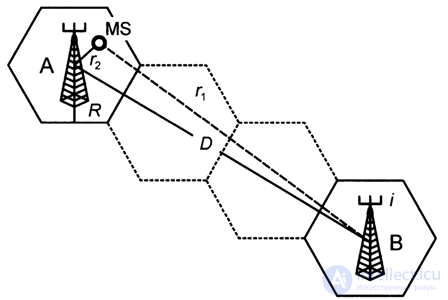 As shown in [7.1], the transmission quality, expressed through the BER value, in cellular systems is most influenced by thermal noise and co-channel interference. In fig. 7.3 shows a simple model of reuse channels in the service area.
As shown in [7.1], the transmission quality, expressed through the BER value, in cellular systems is most influenced by thermal noise and co-channel interference. In fig. 7.3 shows a simple model of reuse channels in the service area.
If we assume that the local average values of the useful signal and interference are the values of x and v>, respectively, then assuming that x and v are subjected to mutually independent logarithmically normal shading, we obtain the joint probability density function of the values of Xi v in the form [7.1]:
Fig. 7.3. Model reuse channels in the service area.

signal / interference, as the smallest values of C / N (Gpor) and SC (Lpor), at which a valid BER value is provided. After the corresponding transformations [7.1], we obtain the final expression that determines the probability that Г ^ Гпор or Л ^ Apor:
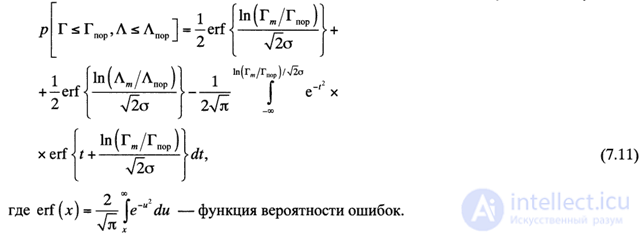
This expression allows, depending on how the energy reserves of C / N and SC are redistributed, to evaluate the possible values of the probability of loss of communication. The calculation by the formula (7.11) allows estimating the energy reserves by the signal / interference ratio S / I and signal / noise S / N, while, as shown in [7.2], the reliability of communication in the presence of thermal noise and co-channel interference should be determined based on scale of the system and its quality level. For example, when a total value of the probability of loss of communication Pb ~ 0.1 is allowed, then a link can be calculated: either for conditions when the C / N margin is -15 dB, and the CII margin is 12 dB, that is, you can assume give priority to thermal noise, or for conditions when C / N <10 dB, and SC ~ 15 dB, that is, assume that you can give priority to co-channel interference, the first option is more suitable for a cellular system with large cell sizes, and the second - for a system with a small size of cells and a large capacity.
When the reliability of communication is determined for the relevant factors separately, then the energy reserves for C / N and the SC can be calculated separately. For example, if the total probability of loss of communication is Pb ~ 0.05 and of these, 0.01 parts are allocated for thermal noise, and 0.04 parts are associated with co-channel interference, then the required energy reserves for C / N and SC are determined by solving the equation (7.11). In this example, the values of C / N and SC at Pb> 0.05 are the following: C / N ~ 15 dB, SC ~ 16 dB. Based on the relationship between reliability of communication and energy reserves, you can find the transmitter power and channel reuse interval, which are the main parameters when calculating a mobile communication line. The threshold values for the local average C / N (D) and the local average SO (L) are set taking into account the quality requirements of the transmission under the influence of pure Rayleigh fading without taking into account the log-normal shading. The permissible values of the probability of loss of radio communication due to exposure to thermal noise and co-channel interference can be determined separately, depending on the signal level and the C IN and SC relations. In [7.1], algorithms for determining transmitter power with given geographical communication losses, probability of communication loss within a cell, at the cell boundary, taking into account C / N margin, required BER probability, C / N threshold value, and radio link parameters (Fig. 7.4), according to the formula:
where Gt is the territorial average of the signal and C / N, kTBNF is the receiver noise power, LP is the power loss at a distance from BTS to MS, GBts and Gms are the antenna gains of the BTS and MS antennas, including losses in the transmitter and receiver feeders, respectively.
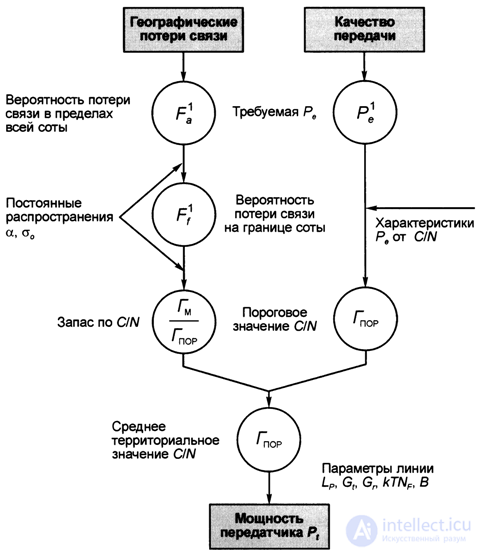
Fig. 7.4. The procedure for determining the required power of the mobile station transmitter [7.1]

Thus, q = D / R is the minimum channel reuse interval normalized to the cell radius R.
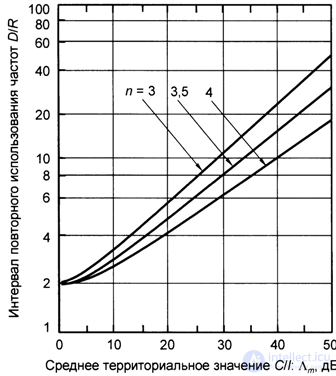
Fig. 7.5. Graphs of the dependence of the reuse interval of channels from the territorial average value of C //
An example of the calculation of the radio line of a digital microcellular system.
Formulation of the problem. Let the problem of determining the power of the mobile station PMS and the frequency reuse interval q = D / R be solved under the following conditions:
- the average frequency of the operating frequency range / Cf = 900 MHz;
- cell radius R = 3 km;
- standard deviation for log-normal shading a0 = 6 dB;
- propagation constant n = 3,5;
- it is required to ensure the average probability BER Рв = 10 ~ 3 and the probability of radio communication loss Рг_с = 10%, and the assumption is introduced that these values are divided equally between thermal noise and co-channel interference on the main reception channel;
- modulation type and demodulation scheme: MSK with autocorrelation demodulation;
- The required bandwidth B at a transmission rate of 16 kbps is 16 kHz.
In fig. 7.6 shows the algorithm for calculating the power of the receiver PMs and the coefficient q, with additional conditions to the above:
- noise power at the receiver input MS Рш ~ & TBNF = -168 dBm / Hz,
- power loss over the length R = 3 km —LP = 137 dB,
- GBTS GMS product = 8 dB.
As follows from the obtained values, the value of Рмs ^ 1 W, aq = D / R ^ 8,2, that is, the number of cells in a cluster: Nck = с ^ / Ь = 22 cells (multi-cell cluster).
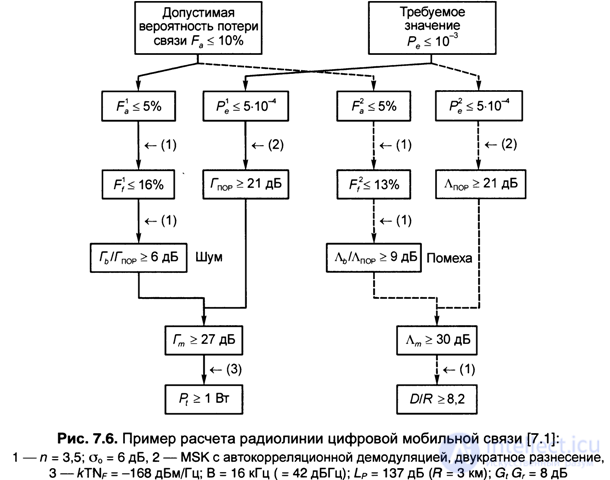
It should be noted that the calculation took into account the values: ГПор ^ 21 dB, Apor ^ 21 dB, Gt / Gpore ^ 6 dB (noise), Am / Aor ^ 9 dB (co-channel interference), Gt ^ 27 dB, Am ^ 30 dB, and when assessing the quality of the transmission, a 2 dB degradation was taken into account.
When taking into account the effects of six interfering BTS, to the average territorial value of C / N = Aw = 30 dB, you must add 8 dB, that is, Aw = 38 dB.
Spatial diversity as a means of combating fast Rayleigh fading due to multipath effectively reduces the allowable local average values of C / N and SP.
The BTS explode method, implemented by handover control and used to eliminate the shadowing effect, reduces the required C / N and C / 1 stocks.
Comments
To leave a comment
GSM Basics
Terms: GSM Basics